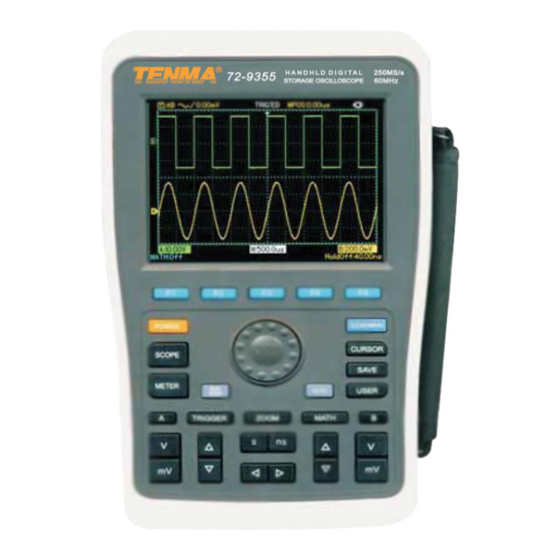
Table of Contents
Advertisement
Quick Links
Advertisement
Table of Contents

Summarization of Contents
PRODUCT OVERVIEW
Main Features
Lists the primary capabilities and functionalities of the digital storage oscilloscope.
WHAT'S INCLUDED
Included Accessories
Details the items provided with the oscilloscope, such as probes and cables.
OPERATING PARAMETERS
Key Operating Parameters
Describes user-friendly interface, powerful analysis, and clear LCD for efficient operation.
CONTROLS AND CONNECTIONS
Front Panel Controls
Explains the function keys, jog dial, and display panel elements for easy operation.
OPERATION
Power on the Unit
Guides on powering up the unit and initiating the self-calibration process for optimal performance.
Accessing Signals
Instructions on connecting probes and setting attenuation for accurate signal measurement.
Autoset Waveform Display
Explains the autoset function for automatic adjustment of waveform display settings.
Display Setting Controls
Using the Autoset Function
Details on connecting a signal and using the AUTO button for automatic display setup.
Vertical Control
How to adjust vertical range (V/div) and position of the waveform.
Horizontal Control
How to change horizontal time base and adjust waveform position.
Trigger System Overview
Introduction to the trigger system for waveform setup and adjustment.
INSTRUMENT SETUP
Resetting the Instrument
Steps to restore the oscilloscope to its factory default setup.
Jog Dial Functionality
Explains the use of the jog dial for menu navigation and parameter selection.
Vertical System Setup
Guide to setting up individual channel parameters like input, coupling, and bandwidth.
Channel Coupling and Bandwidth Settings
Setting Channel Coupling
Details on setting channel coupling modes (DC, AC, GND) for signal input.
Setting Channel Bandwidth Limit
Instructions for setting the channel bandwidth limit to reduce display noise.
Channel Configuration Settings
Setting Bias Voltage
Adjusting channel bias voltage to offset DC quantities for better AC signal observation.
Setting the Probe Rate
Ensuring probe attenuation factor matches oscilloscope settings for correct readings.
Setting Waveform Polarity
How to invert the waveform display for signal analysis.
Changing Signal Time Base
Adjusting the horizontal scanning rate to view waveform details.
Trigger System Setup
Adjusting Hold-off Time
How to adjust hold-off time for observing complex waveforms and synchronization.
Trigger Modes
Pulse Trigger
How to set trigger conditions based on pulse width for capturing abnormal pulses.
Video Trigger
Configuration for triggering using NTSC or PAL standard video signals.
Alternate Trigger
Using alternate trigger mode for observing two uncorrelated signals or comparing pulse widths.
DEFINITIONS
Trigger Source Definition
Explains trigger sources like input channels A, B, and alternate.
Trigger Mode Definition
Describes trigger modes: auto, normal, and single for waveform acquisition.
Trigger Coupling Definition
Defines coupling modes (DC, AC, LF/HF suppression) affecting trigger signals.
Acquisition Modes and Display
Pre-trigger and Delayed Trigger
How to view data sampled before or after the trigger point.
Acquisition Modes, Display, and Measurement
Covers sampling modes, display types, and automatic measurement functions.
OPERATION
Displaying Measurement Values
Steps to display peak-to-peak values and all measurement parameters for Channel A.
Automatic Measurement Parameters
Lists voltage and time parameters the oscilloscope can automatically measure.
Storage and Screen Copy
Storage Setups and Screen Copy
How to save and recall waveforms, setups, and capture screen images to a USB device.
Recall Functionality
Procedures for recalling saved setups and waveforms from internal memory or USB.
Waveform Recording and Playback
Recalling USB Waveform Documents
Steps to import and playback waveform documents saved on a USB device.
Recording Waveforms
Instructions on how to record waveforms and save them internally or to a USB device.
CURSOR MEASUREMENT
Voltage/Time Measurement Modes
How to use cursors for measuring voltage (ΔV) and time (Δt) differences.
UTILITY FUNCTION SETUP
Energy Saving and Auto Calibration
Settings for auto power-off and running auto calibration for accurate measurements.
OPERATING MATH FUNCTIONS
FFT Spectrum Analysis
Using FFT to convert time domain signals to frequency domain for analysis.
FFT Window Selection
Explanation of different FFT window functions and their suitability for measurement.
USING THE RUN BUTTON
Auto Setup Function
How to use the AUTO button for automatic adjustment of waveform display parameters.
MULTIMETER MEASUREMENT
Measurement Modes and Range
Instructions for using the built-in multimeter for various electrical measurements.
SYSTEM PROMPTS
System Prompt Definitions
Explains various system messages and prompts displayed by the oscilloscope.
TROUBLESHOOTING
Troubleshooting Common Issues
Guides on diagnosing and resolving common problems like no display or unstable waveforms.
UPGRADE
Product Program Upgrade
Information on obtaining and preparing software upgrades for the oscilloscope.
Upgrade Procedure
Step-by-step instructions for installing the software upgrade via USB.
SPECIFICATIONS
Sampling and Input Specifications
Details on sampling modes, rates, input impedance, and voltage limits.
Horizontal and Vertical Specifications
Technical details on scanning range, bandwidth, rise time, and A/D converter.
MAINTENANCE
Cleaning Procedures
Guidelines for safely cleaning the oscilloscope casing and display screen.
















Need help?
Do you have a question about the 72-9360 and is the answer not in the manual?
Questions and answers